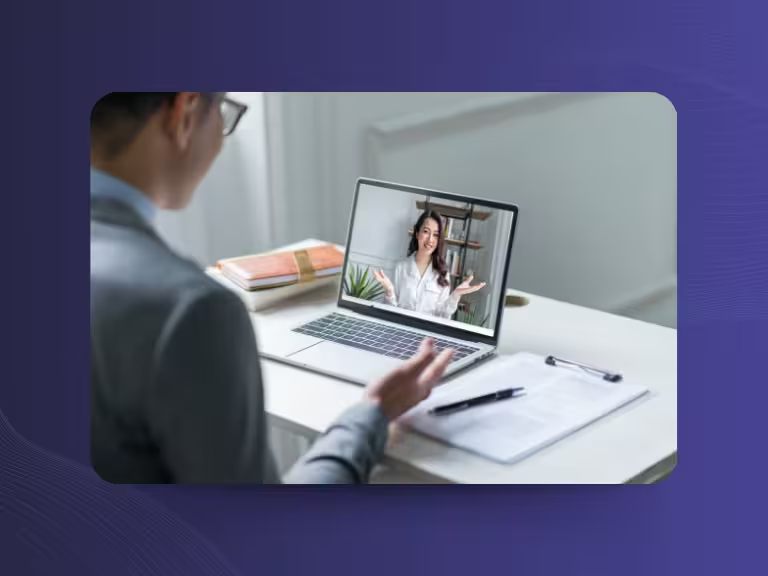Table of Contents
Remote job interviews have become an indispensable part of the modern working world. Since the pandemic, virtual interviews have evolved from an emergency solution to a standard practice – over 75% of companies now use them regularly in their recruiting process. But what is often practical and cost-effective for companies brings new challenges for applicants: technology must work flawlessly, communication becomes more complex, and the interview format requires completely new strategies.
The good news: With the right preparation and appropriate techniques, you can master your next remote interview with confidence. This article shows you how to prepare optimally, overcome technical hurdles, and convince through strong communication. We also address cultural sensitivity and long-term strategies – because remote competence is becoming increasingly important in the digitalized working world.
Preparing for Remote Job Interviews – Laying the Foundation
Technical Preparation – Mastering Technology with Confidence
Nothing is more embarrassing than an interview being cut short due to technical problems. Studies show that 80% of applicants have experienced difficulties due to technical glitches at some point. Therefore, thorough technical preparation is absolutely essential.
Test your internet connection at least one day before the appointment. WiFi can be unstable – use a cable connection if possible. Check your camera, microphone, and speakers thoroughly. Many laptops have weak built-in microphones that make your voice sound tinny.
Install the required software (Zoom, Microsoft Teams, Google Meet) in advance and test all functions. Create a test account and make a trial call. This way, you'll quickly notice if your microphone is set too low or if the camera is working poorly.
Think about backup solutions: Keep your smartphone ready and note down the company's phone number. If your laptop fails, you can quickly switch to your phone or continue by telephone if necessary.
The Perfect Interview Location – Quiet, Professional, and Distraction-Free
Your interview space should be quiet, well-lit, and appear professional. Choose a neutral background – a white wall or a tidy bookshelf work well. Avoid busy wallpaper or personal items in the background.
The lighting should come from the front, ideally from a window. If you sit with your back to the window, you'll appear as a silhouette. Test different positions and see where you look best.
Dress exactly as you would for an in-person interview – even if only your upper body is visible. The right outfit gives you confidence and shows professionalism.
Ensure absolute quiet: Inform roommates, turn phones to silent, and keep pets out of the room. Nothing appears more unprofessional than barking dogs or ringing phones in the background.

Mental Preparation and Self-Presentation
Remote interviews require different skills than in-person conversations. Practice your answers in front of the camera – speaking to a screen feels different than having a direct counterpart.
Prepare for typical remote-specific questions: "How do you organize yourself when working from home?" or "What experience do you have with digital collaboration?" are common topics.
Develop strategies against nervousness: Deep breathing exercises before the interview help. Keep a glass of water nearby and don't hesitate to take short breaks when you need to think.
Technical Aspects and Handling Digital Tools
Overview of Common Remote Interview Tools
Zoom, Microsoft Teams, and Google Meet dominate the remote job interview landscape. Each platform has its peculiarities: Zoom offers many setting options, Teams integrates well into the Microsoft ecosystem, and Google Meet scores points with simplicity.
Some companies use specialized recruiting platforms like HireVue or Talview. These often offer additional features like recording or automatic evaluation. Research the planned platform in advance and familiarize yourself with the basic functions.
Pay attention to data protection and security: Reputable companies use secure, GDPR-compliant tools. Be cautious with unknown platforms or if you're asked to install personal software.
Problems and Solutions in Remote Interviews
Technical problems happen – your reaction is what matters. If the image freezes or the connection breaks, stay calm and communicate proactively. A simple "Sorry, I didn't catch that, could you repeat it?" appears more professional than panicked clicking around.
For longer outages, offer alternative solutions: "Should we call briefly until the connection is stable again?" shows flexibility and problem-solving competence.
Document important points even during technical problems. Tools like Sally can help here – they record conversations and automatically create summaries in case you miss important information due to technical difficulties.

Communication Strategies for Remote Interview Success
Managing Virtual Conversations with Confidence
Eye contact is the cornerstone of virtual communication. Look at the camera, not at the screen – even if it feels unnatural. Stick a small sticker next to the camera as a reminder.
Speak slower and more clearly than usual. Internet delays can cause conversation partners to interrupt each other. Make conscious pauses and wait to see if your counterpart wants to say something else.
Use your body language even within the frame: Nodding, smiling, and open gestures come across well on camera too. Avoid hectic movements – they often appear amplified on video.
Handling pauses is crucial: Silence feels longer virtually than in reality. Feel free to say "Let me think about that for a moment" instead of answering hastily.
Demonstrating Soft Skills and Emotional Intelligence
Building trust virtually is more difficult, but not impossible. Show genuine interest through targeted follow-up questions and active listening. Repeat important points to show that you're paying attention.
Empathy can also be conveyed digitally: React to your conversation partner's mood and adjust your communication accordingly. If the interviewer seems stressed, feel free to offer a short break.
Flexibility is a valued soft skill in remote settings. Show that you can handle unexpected situations – whether it's a technical glitch or a changed conversation style.
Cultural Sensitivity, Feedback, and Long-term Application Strategies
Considering Cultural Differences in Remote Interviews
International remote interviews bring cultural peculiarities with them. In some cultures, direct eye contact (even to the camera) is less common, while in others, small talk is expected before the actual interview begins.
Research the company culture and possible cultural backgrounds of your conversation partners. A quick look at the interviewers' LinkedIn profiles can help you find the appropriate communication style.
Time zone differences can play a role – show understanding if your conversation partner is interviewing at unusual times or appears tired.
Post-Interview Feedback – Actively Requesting and Using It
Only about 35% of applicants receive systematic feedback after remote interviews – yet it's particularly valuable. Ask politely: "Could you give me brief feedback on my presentation? That would help me greatly in my development."
Use received feedback constructively: Positive feedback reinforces you, while critical points show development opportunities. Document important feedback points for future interviews.
You can also ask for feedback after rejections. Many companies appreciate this professionalism and are happy to give improvement suggestions.
Long-term Development Strategies for Remote Competencies
Remote competence is becoming increasingly important. Build it systematically by participating in webinars, online workshops, and virtual networking events. Here you practice not only the technology but also communication in digital formats.
Develop your digital personal brand: A professional LinkedIn presence, thoughtful online presence, and active participation in professional discussions in digital communities strengthen your visibility.
Learn from others' success stories: Exchange experiences with colleagues who have successfully mastered remote interviews. Experience reports provide valuable insights into different strategies and approaches.
Digital tools can support your development: Platforms like Sally help analyze and improve your own conversation skills by recording meetings and creating structured summaries.
Conclusion and Summary
Remote job interviews are more than just a digital copy of the classic interview – they are a standalone format with special requirements and opportunities. The key to success lies in thorough preparation: from technical equipment to selecting the right location to mental preparation.
Technical security creates the foundation for a successful conversation. Backup solutions and trial runs give you the necessary composure. Communication strategies like conscious eye contact with the camera and modulated speech significantly enhance your impact.
Your soft skills are particularly important: Emotional intelligence, empathy, and flexibility help build trust even across distances. Cultural sensitivity and active feedback solicitation round out your professional appearance.
View remote interviews as an opportunity for personal development. The digital competencies you build in the process will be of great benefit to you in the increasingly digitalized working world. With the right preparation and attitude, you won't just successfully master your next remote job interview – you'll use it as a springboard for your professional future.

Try meeting transcription now!
Experience how effortless meeting notes can be – try Sally free for 4 weeks.
Test NowOr: Arrange a Demo Appointment

.avif)


